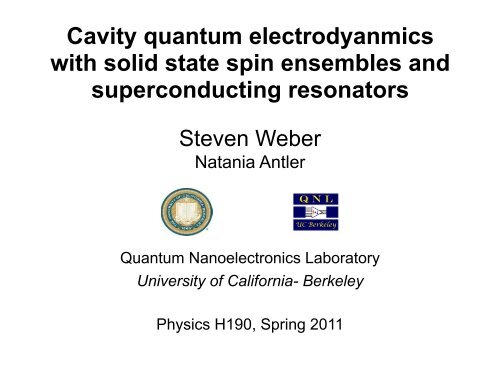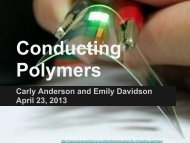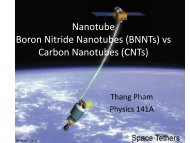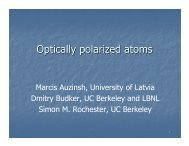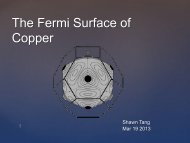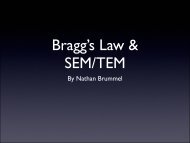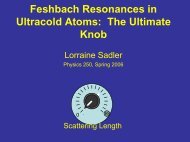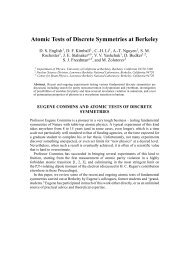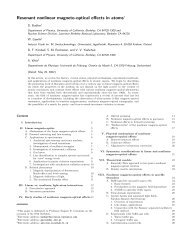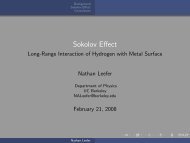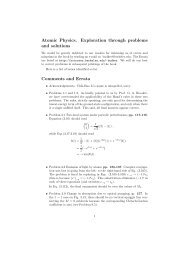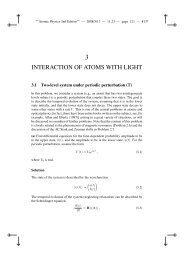Cavity quantum electrodyanmics with solid state spin ensembles ...
Cavity quantum electrodyanmics with solid state spin ensembles ...
Cavity quantum electrodyanmics with solid state spin ensembles ...
Create successful ePaper yourself
Turn your PDF publications into a flip-book with our unique Google optimized e-Paper software.
<strong>Cavity</strong> <strong>quantum</strong> <strong>electrodyanmics</strong><br />
<strong>with</strong> <strong>solid</strong> <strong>state</strong> <strong>spin</strong> <strong>ensembles</strong> and<br />
superconducting resonators<br />
Steven Weber<br />
Natania Antler<br />
Quantum Nanoelectronics Laboratory<br />
University of California- Berkeley<br />
Physics H190, Spring 2011
<strong>Cavity</strong> <strong>quantum</strong> <strong>electrodyanmics</strong><br />
<strong>with</strong> <strong>solid</strong> <strong>state</strong> <strong>spin</strong> <strong>ensembles</strong> and<br />
superconducting resonators<br />
Steven Weber<br />
Natania Antler<br />
Quantum Nanoelectronics Laboratory<br />
University of California- Berkeley<br />
Physics H190, Spring 2011
-atom in a cavity<br />
<strong>Cavity</strong> QED
<strong>Cavity</strong> QED<br />
-atom in a cavity<br />
-ensemble of <strong>spin</strong>s<br />
coupled to a superconducting<br />
resonator
Motivation<br />
- Collective coupling strong coupling<br />
- Long coherence times<br />
- Swap <strong>quantum</strong> <strong>state</strong> between a superconducting<br />
qubit and the <strong>spin</strong> ensemble <strong>quantum</strong> memory<br />
-Access new regimes of cavity QED
Outline<br />
- <strong>Cavity</strong> QED<br />
- Superconducting resonators<br />
- Coupling NV centers to a resonator<br />
- Outlook
<strong>Cavity</strong> QED<br />
CHAPTER 2. CAVITY QUANTUM ELECTRODYNAMICS 35<br />
γ ⊥<br />
from <strong>quantum</strong> optics group at CalTech<br />
g<br />
κ<br />
T transit<br />
Figure 2.1: A two level atom interacts <strong>with</strong> the field inside of ahighfinessecavity. Theatom<br />
coherently interacts <strong>with</strong> the cavity at a rate, g. Alsopresentaredecoherenceprocessesthatallow<br />
the photon to decay at rate κ, theatomtodecayatrateγ ⊥ into modes not trapped by the cavity,<br />
and the rate at which the atom leaves the cavity, 1/T . To reach the strong coupling limit the<br />
interaction strength must larger than the rates of decoherence g>κ, γ ⊥ , 1/T transit .<br />
leakage or absorption by the cavity results in a photon decay rate, κ, sometimesexpressedinterms<br />
of the quality factor Q = ω r /κ. Often, and particularly in circuit QED, κ is set by the desired<br />
transparency of the mirrors to allow some light to be transmitted to a detector as a means of<br />
probing the dynamics of the system. In the absence of other decay mechanisms, the radiative decay<br />
of the atom can be completely described in terms of the coherent interaction <strong>with</strong> the cavity and<br />
decay of cavity photons (which are measured). This very well modeled (and often slow) decay makes<br />
cavity QED a good test-bed for studying <strong>quantum</strong> measurement and open systems [Mabuchi2002].
<strong>Cavity</strong> QED<br />
CHAPTER 2. CAVITY QUANTUM ELECTRODYNAMICS 35<br />
ystemforstudyingtheinteractionbetweenmatter and light is<br />
a dipole coupling <strong>with</strong> a cavity, described by aharmonicoscillato<br />
γ ⊥<br />
from <strong>quantum</strong> optics group at CalTech<br />
g<br />
κ<br />
T transit<br />
e Fig. 2.1). The coherent behavior of this coupled system is descri<br />
iltonian [Walls2006]:<br />
Figure 2.1: A two level atom interacts <strong>with</strong> the field inside of ahighfinessecavity. Theatom<br />
coherently interacts <strong>with</strong> the cavity at a rate, g. Alsopresentaredecoherenceprocessesthatallow<br />
Jaynes-Cummings Hamiltonian<br />
the photon to decay at rate κ, theatomtodecayatrateγ ⊥ into modes not trapped by the cavity,<br />
and the rate at which the atom leaves the cavity, 1/T . To reach the strong coupling limit the<br />
interaction strength must larger than the rates of decoherence g>κ, γ ⊥ , 1/T transit .<br />
H JC = ω r (a † a +1/2) + ω a<br />
2 σ z + g(a † σ − + aσ + )<br />
leakage or absorption by the cavity results in a photon decay rate, κ, sometimesexpressedinterms<br />
of the quality factor Q = ω r /κ. Often, and particularly in circuit QED, κ is set by the desired<br />
transparency of the mirrors to allow some light to be transmitted to a detector as a means of<br />
probing the dynamics of the system. In the absence of other decay mechanisms, the radiative decay<br />
of the atom can be completely described in terms of the coherent interaction <strong>with</strong> the cavity and<br />
term represents the energy of the electromagnetic field, where each<br />
decay of cavity photons (which are measured). This very well modeled (and often slow) decay makes<br />
cavity QED a good test-bed for studying <strong>quantum</strong> measurement and open systems [Mabuchi2002].
<strong>Cavity</strong> QED<br />
CHAPTER 2. CAVITY QUANTUM ELECTRODYNAMICS 35<br />
ystemforstudyingtheinteractionbetweenmatter and light is<br />
a dipole coupling <strong>with</strong> a cavity, described by aharmonicoscillato<br />
γ ⊥<br />
from <strong>quantum</strong> optics group at CalTech<br />
g<br />
κ<br />
T transit<br />
e Fig. 2.1). The coherent behavior of this coupled system is descri<br />
iltonian [Walls2006]:<br />
Figure 2.1: A two level atom interacts <strong>with</strong> the field inside of ahighfinessecavity. Theatom<br />
coherently interacts <strong>with</strong> the cavity at a rate, g. Alsopresentaredecoherenceprocessesthatallow<br />
Jaynes-Cummings Hamiltonian<br />
the photon to decay at rate κ, theatomtodecayatrateγ ⊥ into modes not trapped by the cavity,<br />
and the rate at which the atom leaves the cavity, 1/T . To reach the strong coupling limit the<br />
interaction strength must larger than the rates of decoherence g>κ, γ ⊥ , 1/T transit .<br />
H JC = ω r (a † a +1/2) + ω a<br />
leakage or absorption by the cavity results in a photon decay rate, κ, sometimesexpressedinterms<br />
of the quality factor Q = ω r /κ. Often, and particularly in circuit QED, κ is set by the desired<br />
<strong>Cavity</strong><br />
2 σ z + g(a † σ − + aσ + )<br />
transparency of the mirrors to allow some light to be transmitted to a detector as a means of<br />
probing the dynamics of the system. In the absence of other decay mechanisms, the radiative decay<br />
of the atom can be completely described in terms of the coherent interaction <strong>with</strong> the cavity and<br />
term represents the energy of the electromagnetic field, where each<br />
decay of cavity photons (which are measured). This very well modeled (and often slow) decay makes<br />
cavity QED a good test-bed for studying <strong>quantum</strong> measurement and open systems [Mabuchi2002].
<strong>Cavity</strong> QED<br />
CHAPTER 2. CAVITY QUANTUM ELECTRODYNAMICS 35<br />
ystemforstudyingtheinteractionbetweenmatter and light is<br />
a dipole coupling <strong>with</strong> a cavity, described by aharmonicoscillato<br />
γ ⊥<br />
from <strong>quantum</strong> optics group at CalTech<br />
g<br />
κ<br />
T transit<br />
e Fig. 2.1). The coherent behavior of this coupled system is descri<br />
iltonian [Walls2006]:<br />
Figure 2.1: A two level atom interacts <strong>with</strong> the field inside of ahighfinessecavity. Theatom<br />
coherently interacts <strong>with</strong> the cavity at a rate, g. Alsopresentaredecoherenceprocessesthatallow<br />
Jaynes-Cummings Hamiltonian<br />
the photon to decay at rate κ, theatomtodecayatrateγ ⊥ into modes not trapped by the cavity,<br />
and the rate at which the atom leaves the cavity, 1/T . To reach the strong coupling limit the<br />
interaction strength must larger than the rates of decoherence g>κ, γ ⊥ , 1/T transit .<br />
H JC = ω r (a † a +1/2) + ω a<br />
leakage or absorption by the cavity results in a photon decay rate, κ, sometimesexpressedinterms<br />
of the quality factor Q = ω r /κ. Often, and particularly in circuit QED, κ is set by the desired<br />
<strong>Cavity</strong><br />
2 σ z + g(a † σ − + aσ + )<br />
Atom<br />
transparency of the mirrors to allow some light to be transmitted to a detector as a means of<br />
probing the dynamics of the system. In the absence of other decay mechanisms, the radiative decay<br />
of the atom can be completely described in terms of the coherent interaction <strong>with</strong> the cavity and<br />
term represents the energy of the electromagnetic field, where each<br />
decay of cavity photons (which are measured). This very well modeled (and often slow) decay makes<br />
cavity QED a good test-bed for studying <strong>quantum</strong> measurement and open systems [Mabuchi2002].
<strong>Cavity</strong> QED<br />
CHAPTER 2. CAVITY QUANTUM ELECTRODYNAMICS 35<br />
ystemforstudyingtheinteractionbetweenmatter and light is<br />
a dipole coupling <strong>with</strong> a cavity, described by aharmonicoscillato<br />
γ ⊥<br />
from <strong>quantum</strong> optics group at CalTech<br />
g<br />
κ<br />
T transit<br />
e Fig. 2.1). The coherent behavior of this coupled system is descri<br />
iltonian [Walls2006]:<br />
Figure 2.1: A two level atom interacts <strong>with</strong> the field inside of ahighfinessecavity. Theatom<br />
coherently interacts <strong>with</strong> the cavity at a rate, g. Alsopresentaredecoherenceprocessesthatallow<br />
Jaynes-Cummings Hamiltonian<br />
the photon to decay at rate κ, theatomtodecayatrateγ ⊥ into modes not trapped by the cavity,<br />
and the rate at which the atom leaves the cavity, 1/T . To reach the strong coupling limit the<br />
interaction strength must larger than the rates of decoherence g>κ, γ ⊥ , 1/T transit .<br />
H JC = ω r (a † a +1/2) + ω a<br />
leakage or absorption by the cavity results in a photon decay rate, κ, sometimesexpressedinterms<br />
of the quality factor Q = ω r /κ. Often, and particularly in circuit QED, κ is set by the desired<br />
<strong>Cavity</strong><br />
2 σ z + g(a † σ − + aσ + )<br />
Atom<br />
Interaction<br />
transparency of the mirrors to allow some light to be transmitted to a detector as a means of<br />
probing the dynamics of the system. In the absence of other decay mechanisms, the radiative decay<br />
of the atom can be completely described in terms of the coherent interaction <strong>with</strong> the cavity and<br />
term represents the energy of the electromagnetic field, where each<br />
decay of cavity photons (which are measured). This very well modeled (and often slow) decay makes<br />
cavity QED a good test-bed for studying <strong>quantum</strong> measurement and open systems [Mabuchi2002].
limit (ω a − ω r ≪ g), the atom and photon can exchange energy causin<br />
<strong>Cavity</strong> QED<br />
CHAPTER 2. CAVITY QUANTUM ELECTRODYNAMICS 35<br />
character, and forming a strongly coupled system. In many cases it is<br />
to be dispersive, where no actual photons are absorbedbytheatom<br />
uning the atom and cavity by ∆ = gω a −ω ar −where ω r ≡g∆<br />
≪ ∆. In this di<br />
γ ⊥<br />
from <strong>quantum</strong> optics group at CalTech<br />
g<br />
κ<br />
T transit<br />
dipole interaction can be modeled using (non-degenerate) perturbati<br />
anding in powers of g/∆ to second order yields the approximate Ham<br />
Figure 2.1: A two level atom interacts <strong>with</strong> the field inside of ahighfinessecavity. Theatom<br />
coherently<br />
Dispersive<br />
interacts <strong>with</strong> the cavity<br />
limit:<br />
at a rate,<br />
∆<br />
g. Alsopresentaredecoherenceprocessesthatallow<br />
≡ ω the photon to decay at rate κ, theatomtodecayatrateγ ⊥ into modes not trapped by the cavity,<br />
and the rate at which the atom leaves the cavity, 1/T . To a − ω<br />
reach the r g<br />
strong coupling limit the<br />
interaction strength must larger than the rates of decoherence g>κ, γ ⊥ , 1/T transit .<br />
H ≈ <br />
) (ω r + g2 (a<br />
∆ σ z<br />
† a +1/2 ) + ω a σ z /2<br />
leakage or absorption by the cavity results in a photon decay rate, κ, sometimesexpressedinterms<br />
of the quality factor Q = ω r /κ. Often, and particularly in circuit QED, κ is set by the desired<br />
avity still interact<br />
transparency<br />
through<br />
of the mirrorsthe to allowdispersive some light to be transmitted<br />
shift<br />
toterm a detectorproportional as a means of<br />
to g<br />
probing the dynamics of the system.<br />
ω<br />
In the absence of other decay mechanisms, the radiative decay<br />
of atom can be completely described in terms of the coherent interaction <strong>with</strong> cavity and<br />
h the rest of the Hamiltonian it r (|0)+2g 2 /∆ = ω<br />
conserves both thephotonnumber<br />
r (|1)<br />
decay of cavity photons (which are measured). This very well modeled (and often slow) decay makes<br />
cavity QED a good test-bed for studying <strong>quantum</strong> measurement and open systems [Mabuchi2002].<br />
the energies of both the atom and the photons (seeFig.2.2b).<br />
T
limit (ω a − ω r ≪ g), the atom and photon can exchange energy causin<br />
<strong>Cavity</strong> QED<br />
CHAPTER 2. CAVITY QUANTUM ELECTRODYNAMICS 35<br />
character, and forming a strongly coupled system. In many cases it is<br />
to be dispersive, where no actual photons are absorbedbytheatom<br />
uning the atom and cavity by ∆ = gω a −ω ar −where ω r ≡g∆<br />
≪ ∆. In this di<br />
γ ⊥<br />
from <strong>quantum</strong> optics group at CalTech<br />
g<br />
κ<br />
T transit<br />
dipole interaction can be modeled using (non-degenerate) perturbati<br />
g ω a − ω r ≡ ∆ (1)<br />
anding in powers of g/∆ to second order yields the approximate Ham<br />
g ω a − ω r ≡ ∆ (1)<br />
Figure 2.1: A two level atom interacts <strong>with</strong> the field inside of ahighfinessecavity. Theatom<br />
coherently<br />
Dispersive<br />
interacts <strong>with</strong> the<br />
g<br />
cavity<br />
limit:<br />
at<br />
ω<br />
a rate, g. Alsopresentaredecoherenceprocessesthatallow<br />
the photon to decay at rate κ, theatomtodecayatrateγ a −∆ ω≡ r ≡ω ∆ ⊥ into modes not trapped by the cavity,<br />
and the rate at which the atom leaves the cavity, 1/T . To a − ω<br />
reach the r g<br />
strong coupling limit the<br />
interaction strength must larger than the rates of decoherence g>κ, γ ⊥ , 1/T transit .<br />
∆ ≡ ω a − ω r g (2)<br />
H ≈ <br />
) (ω r + g2 (a<br />
∆ σ z<br />
† a +1/2 ) + ω a σ z /2<br />
∆ ≡ ω a − ω r g (2)<br />
<br />
0 1<br />
1<br />
0<br />
leakage or absorption by the cavity results in a photon decay rate, κ, sometimesexpressedinterms<br />
of the quality factor Q = ω r /κ. Often, and particularly in circuit QED, κ is set by the desired<br />
avity still |0interact ≡ transparency , |1 through<br />
of ≡the mirrorsthe to allowdispersive some light to be transmitted to a detector as a means of<br />
ω probing the dynamics r (|0)+2g 2 shift term (3) proportional to g<br />
/∆ = ω of the system. In the absence of other decay r (|1) mechanisms, the radiative decay<br />
<br />
<br />
ω<br />
of atom can be completely described in terms of the coherent interaction <strong>with</strong> cavity and<br />
h the rest of the Hamiltonian it r (|0)+2g 2 /∆ = ω<br />
conserves both thephotonnumber<br />
r (|1)<br />
≡ , |1 ≡<br />
decay of cavity photons (which are measured). This(3)<br />
very well modeled (and often slow) decay makes<br />
<br />
0<br />
1<br />
<br />
1<br />
0<br />
cavity QED a good test-bed for studying <strong>quantum</strong> measurement and open systems [Mabuchi2002].<br />
the energies ω r (|0)+2g of 2 both /∆ = ωthe r (|1) atom and the photons (4) (seeFig.2.2b).<br />
T
Superconducting Microwave<br />
Resonators<br />
¯h<br />
λ/2<br />
Transmission line resonator
Collective coupling to <strong>spin</strong>s<br />
3mm
ω r (|0)+2g /∆<br />
Collective coupling to <strong>spin</strong>s<br />
3mm<br />
¯h<br />
! "<br />
%&&'(<br />
$<br />
!<br />
"<br />
# $%<br />
#<br />
#&<br />
- Magnetic fields in the resonator<br />
interact <strong>with</strong> the <strong>spin</strong>s<br />
λ/2<br />
-Store a single resonator photon<br />
in a collection of <strong>spin</strong>s<br />
-Coupling strength scales as<br />
√<br />
N<br />
R. H. Dicke, Phys. Rev. 93, 99 (1954)
Strong Coupling<br />
g κ, γ<br />
g ≈ 10 Hz
Strong Coupling<br />
g κ, γ<br />
g κ, γ<br />
κ = 2πf<br />
Q<br />
≈ 1Mhz, for f =2.7 GHz and Q ≈ 10, 000<br />
g ≈ 10 Hz<br />
g ≈ 10 Hz<br />
√<br />
N × g ≈ 10 MHz
Strong Coupling<br />
¯h<br />
g κ, γ<br />
g κ, γ<br />
κ = 2πf<br />
Q<br />
≈ 1Mhz, for f =2.7 GHz and Q ≈ 10, 000<br />
single <strong>spin</strong>:<br />
g ≈ 10 Hz<br />
g ≈ 10 Hz<br />
g ≈ 10 Hz<br />
λ/2<br />
√<br />
N × g ≈ 10 MHz
Strong Coupling<br />
¯h<br />
g κ, γ<br />
g κ, γ<br />
κ = 2πf<br />
Q<br />
≈ 1Mhz, for f =2.7 GHz and Q ≈ 10, 000<br />
single <strong>spin</strong>:<br />
g ≈ 10 Hz<br />
g ≈ 10 Hz<br />
g ≈ 10 Hz<br />
λ/2<br />
√<br />
N × g ≈ 10 MHz
κ = 2πf<br />
Q<br />
Strong Coupling<br />
g κ, γ ¯h<br />
(6)<br />
¯h<br />
g κ, γ<br />
g κ, γ<br />
≈ 1Mhz, for f =2.7 GHz and Q ≈ 10, 000<br />
or f =2.7 GHz andgQ ≈10 10, Hz 000 (7)<br />
single <strong>spin</strong>:<br />
g ≈ 10 Hz<br />
λ/2<br />
g ≈ 10 Hz<br />
g ≈ 10 Hz<br />
√<br />
10 12 <strong>spin</strong>s: N × g ≈ 10 MHz<br />
(8)<br />
√<br />
N × g ≈ 10 MHz
κ = 2πf<br />
Q<br />
Strong Coupling<br />
g κ, γ ¯h<br />
(6)<br />
¯h<br />
g κ, γ<br />
g κ, γ<br />
≈ 1Mhz, for f =2.7 GHz and Q ≈ 10, 000<br />
or f =2.7 GHz andgQ ≈10 10, Hz 000 (7)<br />
single <strong>spin</strong>:<br />
g ≈ 10 Hz<br />
λ/2<br />
g ≈ 10 Hz<br />
g ≈ 10 Hz<br />
√<br />
10 12 <strong>spin</strong>s: N × g ≈ 10 MHz<br />
(8)<br />
√<br />
N × g ≈ 10 MHz
How do we ‘see’ the <strong>spin</strong>s<br />
-Tune the transition frequency across the<br />
resonator frequency<br />
- Look for an avoided crossing
How do we ‘see’ the <strong>spin</strong>s<br />
-Tune the transition frequency across the<br />
resonator frequency<br />
- Look for an avoided crossing<br />
No coupling<br />
Frequency<br />
<strong>spin</strong>s<br />
resonator<br />
Magnetic Field
How do we ‘see’ the <strong>spin</strong>s<br />
-Tune the transition frequency across the<br />
resonator frequency<br />
- Look for an avoided crossing<br />
No coupling<br />
With coupling<br />
Frequency<br />
<strong>spin</strong>s<br />
resonator<br />
Frequency<br />
Magnetic Field<br />
Magnetic Field
How will the <strong>spin</strong>s tune <strong>with</strong> B<br />
[010]<br />
[001]<br />
B<br />
φ<br />
[100]<br />
R. Amsuss, et al., preprint, arXiv:1103.104 (2011)
How will the <strong>spin</strong>s tune <strong>with</strong> B<br />
[010]<br />
[001]<br />
B<br />
φ<br />
[100]<br />
4,II 1,I<br />
3,I<br />
V<br />
2,II<br />
R. Amsuss, et al., preprint, arXiv:1103.104 (2011)
How will the <strong>spin</strong>s tune <strong>with</strong> B<br />
[010]<br />
[001]<br />
B<br />
φ<br />
[100]<br />
4,II 1,I<br />
3,I<br />
V<br />
2,II<br />
(c)<br />
RF out<br />
Frequency (GHz)<br />
3.2<br />
3.1<br />
3.0<br />
2.9<br />
φ=3°<br />
|+> I |+>II<br />
2.8<br />
2.7<br />
|-> II<br />
2.6 |-> I<br />
2.5<br />
0.1<br />
0.0<br />
|0> I<br />
|0><br />
−0.1<br />
II<br />
0 10 20<br />
B (mT)<br />
R. Amsuss, et al., preprint, arXiv:1103.104 (2011)
2<br />
Some results!<br />
(a)<br />
2.73<br />
φ=45°<br />
(b)<br />
φ=3°<br />
(c)<br />
2.72<br />
Frequency (GHz)<br />
2.71<br />
2.7<br />
2.69<br />
(d)<br />
2.68<br />
2.68<br />
−10 |S21| (dB) −60 −20 |S21| (dB) −70<br />
0 5 10<br />
B (mT)<br />
10 15 20<br />
B (mT)<br />
0
Some results!<br />
2<br />
(a)<br />
2.73<br />
(b)<br />
φ=45°<br />
φ=3°<br />
(b)<br />
(c)<br />
φ=3°<br />
(c)<br />
1 x10-3<br />
2.72<br />
0.5<br />
|S21| 2<br />
Frequency (GHz)<br />
mT)<br />
2.71<br />
2.7<br />
2.69<br />
−60 −20 |S21| (dB) −70<br />
2.68<br />
10<br />
2.68 2.69 2.7 2.71 2.72<br />
Frequency (GHz)<br />
(d)<br />
φ=12.3°<br />
−10 |S21| 10 (dB) −60 15 20 −20 |S21| 0 (dB) 5−70<br />
10 15<br />
B (mT)<br />
B (mT)<br />
0<br />
0.02<br />
0<br />
(d)<br />
0.01<br />
2.68<br />
Peak Amplitude<br />
0 5 10<br />
B (mT)<br />
10 15 20<br />
B (mT)<br />
sonator transmission |S 21 | 2 as a function of the magnetic field for (a) ϕ =45 ◦ and (b) ϕ =3 ◦ .While<br />
of the coupled resonator-<strong>spin</strong> ensemble system is observed when ω r = ω−,weseein(b)theadditional<br />
I<br />
ition. (c) Comparison of the vacuum Rabi splitting of 2g I /2π =18.5 MHz for ϕ =45 ◦ (B =8.2 mT)<br />
rger splitting of 2g/2π =26.3 MHz (red line) for ϕ =0 ◦ (B =14.3 mT).Eachdatasetisfittedby<br />
2<br />
0
(a)<br />
2.73<br />
(b)<br />
φ=45°<br />
φ=3°<br />
Some results!<br />
(b)<br />
(c)<br />
φ=3°<br />
¯h ¯h<br />
(c)<br />
1 x10-3<br />
2<br />
Frequency (GHz)<br />
mT)<br />
2.72<br />
2.71<br />
2.7<br />
2.69<br />
−60 −20 |S21| (dB) −70<br />
2.68<br />
10<br />
−10 |S21| 10 (dB) −60 15 20 −20 |S21| 0 (dB) 5−70<br />
10 15<br />
B (mT)<br />
B (mT)<br />
0 5 10<br />
B (mT)<br />
10 15 20 0<br />
2π =26.3 MHz = √ 2 × g I<br />
B (mT)<br />
2<br />
λ/2<br />
0.5<br />
0<br />
2.68 2.69 2.7 2.71 2.72<br />
Frequency (GHz)<br />
(d)<br />
0.02<br />
blue: phi =45 deg, B= φ=12.3° 8.2mT(d)<br />
g I<br />
0.01<br />
red: phi = 0 deg, B= 14.3mT<br />
sonator transmission |S 21 | 2 as a function of the magnetic field for (a) ϕ =45 ◦ and (b) ϕ =3 ◦ .While<br />
of the coupled resonator-<strong>spin</strong> ensemble system is observed when ω r = ω−,weseein(b)theadditional<br />
2π<br />
I 2π<br />
ition. (c) Comparison of the vacuum Rabi splitting of 2g I /2π =18.5 MHz for ϕ =45 ◦ (B =8.2 mT)<br />
rger splitting of 2g/2π =26.3 MHz (red line) for ϕ =0 ◦ (B =14.3 mT).Eachdatasetisfittedby<br />
2π =18.5 MHz<br />
0<br />
|S21| 2<br />
2.68<br />
Peak Amplitude<br />
g<br />
2π =26.3 MHz = √ 2 × g I
Experimental Setup
Experimental Setup
Experimental Setup
Experimental Setup
Experimental Setup
What else can you do<br />
- Use dispersive shift in cavity resonance frequency to<br />
characterize <strong>spin</strong> relaxation time<br />
- Swap experiment: <strong>quantum</strong> memory<br />
- Other <strong>solid</strong> <strong>state</strong> <strong>spin</strong> systems:<br />
Bismuth doped Si<br />
Ruby<br />
N C60
Thanks!


